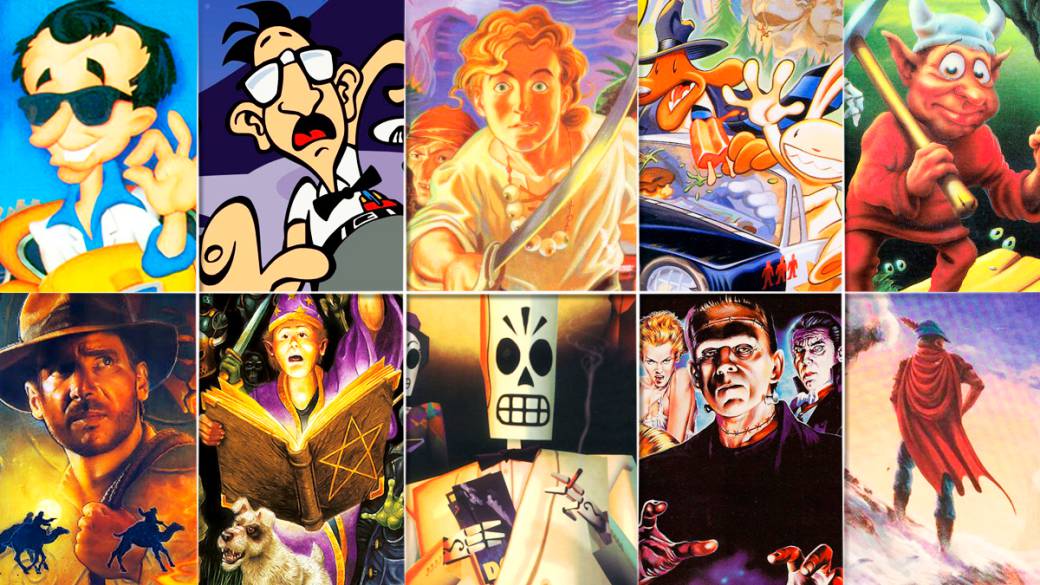
The story of a genre that was the great reference on PC for years, and that took us on wonderful adventures.
Today we look back. We travel back in time with nostalgia to enter one of the best and unforgettable times of adventure adventure games. A golden age in the late 80s and mid 90s, where many companies fought the most arduous battle to get victoriously on the podium. Does Sierra, Adventure Soft, LucasArts or Pendulo Studios sound like something to you? We refer to the arrival of point-n-clicks, a genre that has never ceased to amaze us, be it for its ingenious script twists, its large doses of humor or its extravagant and charismatic characters. With the rise of this genre we have seen everything. From awkward – and endearing – pirate apprentices, mummy-sponsored beauty pageants, part-time soul reapers, to the most internationally renowned archaeologist himself. Today at Meristation we start the time machine to review with you the exciting and hilarious world of point-n-click. A key and indelible genre in the history of video games and particularly in the extensive PC catalog, which has titles each loved and remembered most.
Lets start by the beginning. Therefore, we must go back to its remotest beginnings. We can’t start talking about point-n-clicks without first mentioning their ancestor: conversational adventures. These emerged on the screens of microcomputers in the mid-1970s, although not under the concept that we would commonly imagine. Rather, its beginnings were based on raising a pioneering concept that sought to tell a story and invite us to take sides in it. We can say that the first conversational adventure in fact arises in 1976 with the title “Adventure” or also known as “Colossal Cave Adventure”, where their interactions were made through text commands. With 300KB of central memory, 700 lines of code and under a dark background with luminescent letters, the game posed situations in which the player could first respond to their decisions in written form. The machine and the player spoke in the same language, and it was done in turns. The player typed an action and the game as a result expressed a consequence of our decisions in it. The use of text not only allowed the developers to overcome the shortcomings of the hardware, but also allowed them to harness the player’s imagination to conjure up dramatic scenes. and tense encounters. A huge and ferocious green snake stands in the way! Do you want to take action? Writes
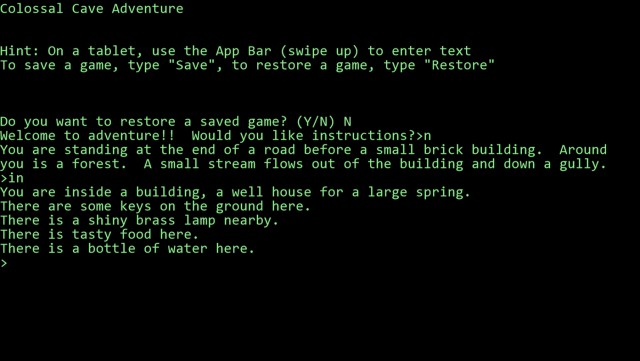
Colossal Adventure (1976) the first conversational adventure
The arrival of the first graphic adventure
We are in the 80’s. A time when 16 or 48kb RAM Spectrum and Amstrad predominated, and in which shortly after, a minority would use color monitors and floppy drives. Right in 1980, the Sierra-Online company, later called Sierra Entertainment, came to change everything. The marriage of Roberta and Ken Williams became fascinated with the possibilities of the genre and set out to create their own conversational adventures known as Hi-Res Adventures. Influenced by “Colossal Cave” in 1980 they jointly developed the first conversational adventure in history that featured monochrome graphics called Mystery House.

Mistery House (1980) Sierra’s first graphic adventure
From here on, the genre would greatly benefit from on-screen graphical use to accompany the usual text descriptions of yesteryear. As in any conversational adventure, in Mistery House (inspired by the novel “Ten black boys” by Agatha Christie) we had to read the text descriptions that the game provided to collect objects and use them as the occasion required. The actions that we did in the title were entered by keyboard, both to move in it “
Conversational adventures pose situations that are described by means of a text and in which the player must answer how he wants to face them from a dialogue.
After several years of success, gamers who initially received the conversational adventure as a pioneer began to demand new challenges, and although the developers tried to provide them, the technology was still evolving at a very slow pace. To sustain the genre it was not enough to add small graphical improvements or new functionalities, it required going much further.
The conversational adventure comes to Spain with Dinamic
The conversational adventures continued to triumph during the following years until 1984. A year in which the conversational adventure first arrived in Spain under the title Yenght, created by the newly founded Dinamic by the Ruiz brothers. In the mid-80s, the Spectrum was the most commercialized 8-bit machine in the Spanish market, but it was not the only one. Although initially the first Dinamic games came out for Spectrum, the Spanish studio realized that it had to reach more platforms. Does anyone remember The War of the Tableware, Abu Simbel Profanation or Don Quixote? His games starred on numerous covers of the coveted magazines of the time such as ZX or MicroHobby, and made Don Quixote the best-selling text adventure in Spain.
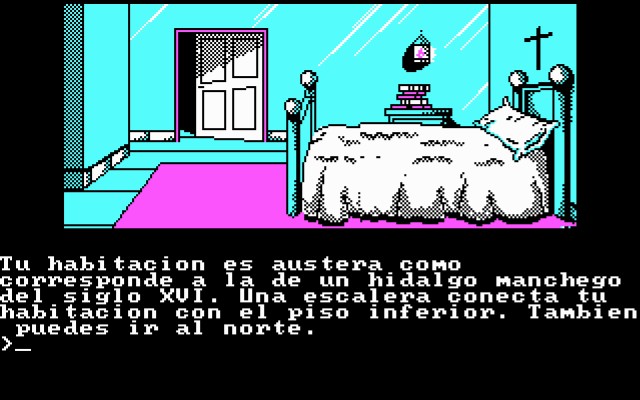
Don Quixote, one of the best-selling text adventures in Spain
Golden age of adventure games 1984-1992
From that moment on, the popular Spanish golden age of graphic adventures was designated, a period that lasted until 1992. While in our country Dinamic filled the market with its titles, outside of it the first drastic change in the genre would be seen. Sierra’s Mistery House title was a commercial success for the fledgling studio, earning a whopping $ 167,000 on its release alone. Because of this, IBM would commission the couple Roberta and Ken Williams to create a game to showcase the visual capabilities of their new PCjr system. In 1984 the studio changed everything with the release of King’s Quest: Quest for the Crown, one of the greatest milestones in the history of adventure games, popularly known for being the first.
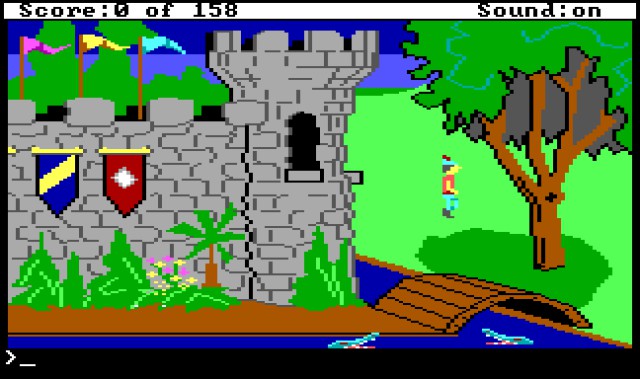
King’s Quest I: Quest for the Crown (1984)
The arrival of King’s Quest revolutionized the industry. Its AGI graphics engine swept away a proposal of up to 160×200 pixels and a maximum of 16 colors, along with its staging of the interface called third-person camera and its primitive pseudo 3D. At this time, the text adventures that had to be written by the player were being built with an interface that proposed different options, and most importantly, it was accompanied by a tremendously pioneering graphic section at that time. Its striking scenarios and complex puzzles (in which we did whatever it was we always died) made the game a great challenge for its players, one of its best installments being King’s Quest VI: Heir Today, Gone tomorrow (1992) one of the first titles that supported animated movie sequences for the first time. Sierra gave rise to the first popular graphic adventure with King’s Quest (1984) and featured great original bets of the genre such as the Space Quest saga in (1986), Police Quest in (1987), Leisure Suit Larry (1987) or “Laura Bow : (1989) and his second installment The dagger of Amon-Ra (1992).
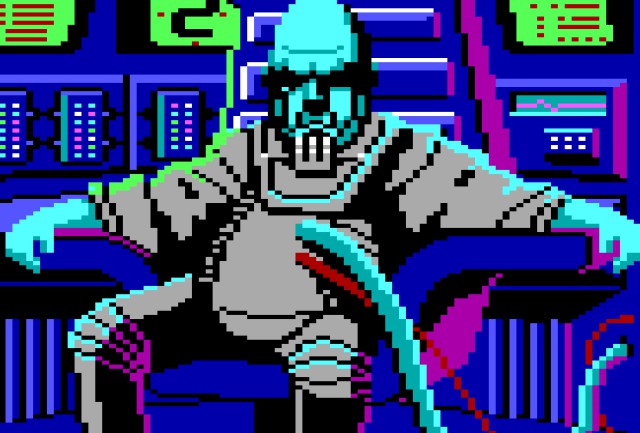
Space Quest II: Vohaul’s Revenge (1987)
Released by Sierra in 1986, Space Quest was a series of comedic sci-fi adventure-focused titles released between 1986 and 1995. The games follow the adventures of an unlucky space janitor named Roger Wilco, who probes the entire galaxy in looking for “truth, justice and really clean floors.” The title initially was not one of the best known of the company (although it was one of the longest-lived sagas) and with the passage of time it was granted its deserved merit within the point-n-click catalog.
If we go back to the beginning of Sierra we have to necessarily talk about Leisure Suit Larry. Larry, or also known as the company’s famous “Hugh Hefner”, was one of Sierra’s most controversial and censored early adventure games. His characteristic sense of humor and racy intentions gave his saga a long and unstoppable trajectory from its first installment in 1987 to 2018 with Leisure Suit Larry: Wet Dreams Don’t Dry.

Leisure Suit Larry 2: Looking for Love -In Several Wrong Places (1988)
Point-n-click fever
The adventure adventure genre started out on the basis of early conversational adventures, and became a popular graphical interface in the mid-1980s through the mid-1990s. Many trends pointed strongly, but no genre has experienced the same meteoric rise as that of the adventure of ‘point and click’, a style of play that rode the crest of the wave of technological advancement in the 1980s by taking advantage of color displays and higher resolution graphics, before capitalizing on the advent of the CD-ROM . Being in this period of time the most golden age of the genre.
First of all, let’s get into its meaning. The so-called point-n-click, are those games in which the mouse of our PC is used exclusively to interact with our environment. Through our mouse, we direct the action of our actions either by choosing actions, managing the inventory, or directing our character. Point-n-clicks are born as a result of the conceptual extension of conversational adventures from their first jogs, being a more contemporary version that went from being called text adventures to point and click adventures.
The most important change was the evolution from going to direct commands through the keyboard, to doing it directly with the mouse pointer. With this, it gave rise to the first point-n-click
Not everything was easy for the Sierra studio, as it had another tough competitor in the late 80s, Lucasfilm Games, later known as LucasArts. Sierra completely dominated the genre and was recognized as the quintessential creator of graphic adventures, however, George Lucas’s new company came stomping to revolutionize the market.
Sierra vs. LucasArts: Duel of the Titans
To put ourselves in context of the history of point-n-clicks, we must refer to LucasArts, formerly LucasFilm Games, a studio created by the renowned filmmaker George Lucas in 1982. A video game developer born under the name of the Lucasfilm film company and that introduces a totally revolutionary concept for the time: the action menu. The study opted for using a menu of actions under selectable commands such as: “
The arrival of the SCUMM engine
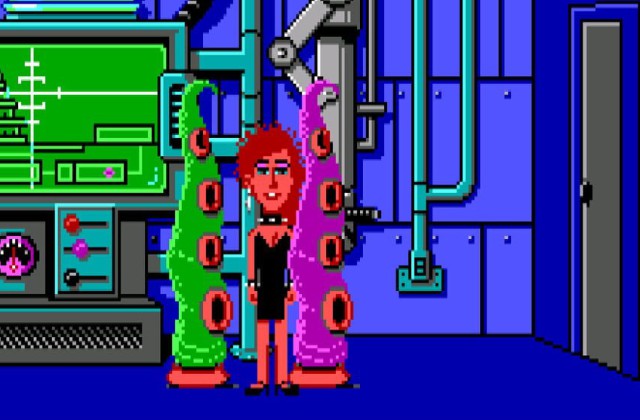
Maniac Mansion the first game to use the SCUMM engine
LucasFilm Games’ success came with the release of their second title in 1987 with Maniac Mansion. A strong and hilarious bet, and one of the most remembered works of point-n-click today. The title laid the foundation for the SCUMM engine that would be used in many other later adventures and that used an engine that had been designed exclusively for its first Maniac Mansion title. SCUMM (Script Creation Utility for Maniac Mansion) allowed us to abandon the classic keyboard commands to be able to use our mouse when performing our movements whose clickable verbs performed actions such as:

Was it scarier than meeting Edna at the mansion?
After its initial success for the Commodore 64 and Apple II, LucasArts subsequently released it for different platforms, such as the Commodore Amiga, Atari ST and even the Nintendo Entertainment System. Many of the later versions had graphical revisions, such as the EGA version for DOS, which has more detailed 16-color graphics.
LucasArts, the kings of Rock n ‘Roll
What was the first; the egg or the chicken? Disney or LucasArts? Or is it now the other way around? In fact, one of the most iconic titles of the 1990 company “The Secret of Monkey Island” was based on the Pirates of the Caribbean (1967) attraction at the Disney World parks, currently known worldwide for its film saga. This attraction, with a pirate setting, served its creator, Ron Gilbert as a reference to create the universe that he ended up calling: Monkey Island. And it is that paradoxically, the star company of graphic adventures LucasArts was bought in 2012 by the giant Disney for the sum of 3,125 million.
Insert Disk 22 and Press Button to Continue
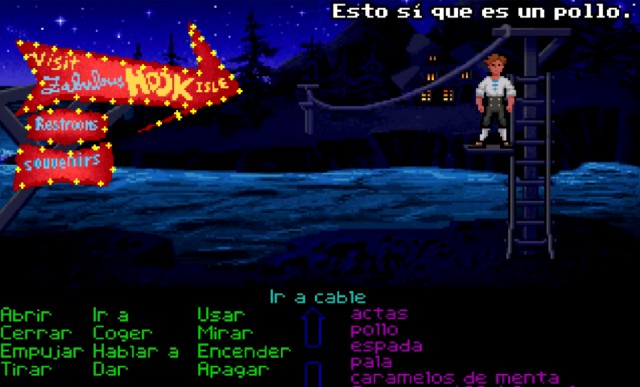
“Use chicken” + in “cable” as an alternative to the neighborhood bus
Good old Guybrush with the unpronounceable last name “Threepwood” made his first steps to become a pirate and show his worth as a swordsman and treasure hunter. With his recognizable phrase: “My name is Guybrush Threepwood, and I want to be a pirate!” our adventure began. In the title we found breathtaking dialogues, endearing characters and all kinds of puzzles from the most logical to the craziest (“use rubber chicken with pulley”), in addition to giving us some of the best insults of media piracy: “Fight! like a farmer! ” “How appropriate, you fight like a cow.”
In 1991 his second installment came out, Monkey Island 2: Lechuck’s Revenge (1991). A title that raised the bar with an obvious graphic improvement going from 16 to 256 colors. A game that dazzled in every way and level: from its animations, settings, characters, colors, music with the IMUSE system, even its plot. Currently considered one of the best games in history, although the end did not satisfy everyone, everything is said.

Monkey Island: Lechuck’s Revenge
The Adventures of Willy Beamish is a graphic adventure was developed by Dynamix, and published in 1991 by Sierra. Known for its realistic cartoon-style graphics and 256-color digitized backgrounds, the title also featured some stunning fully animated scenes. Although initially criticized for its dense text dialogue, it pioneered using some unique concepts such as time use in the game. Since in a totally new way, his puzzles had to be solved within specific periods of time.
Influenced by the most famous crime novels, Laura Bow: Dagger of Amon-Ra was an original point-n-click that recreated a New York of the 20s, full of opportunities and brimming with crime, from the perspective of our young protagonist. Fresh off the newsroom of a coveted magazine, Laura had to uncover the culprit in a series of murders and robberies at the Leyendeker history museum. A “rare bird” proposal that took similarities from the game Cruise for a Corpse published a year earlier in 1991, known for having a similar setting and tone.
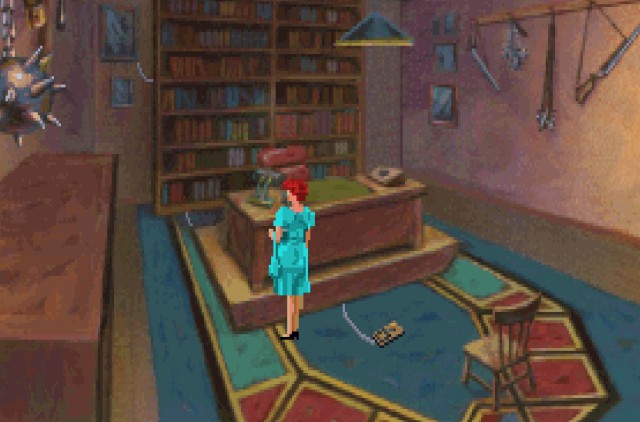
Laura Bow: The dagger of Amon-Ra
In the early 90’s, everything LucasArts touched turned to gold. Just a year after Monkey Island 2 (1991) and after several popular installments such as Zak McKracken (1988), Indiana Jones and the Last Crusade (1989) or Loom (1990), in 1992 the company decided to bring the young Indy back to the company with Indiana Jones and the Fate of Atlantis. It should not be forgotten that before the iconic Lara Croft and Nathan Drake there was Indy, the most coveted in international archeology. We refer to Indiana Jones, the boom that its franchise had in the film industry in the heyday of the 80s, and of course, it also featured a second installment in the form of point-n-click by LucasArts. Its first title, Indiana Jones and the Last Crusade (1989), shaped the plot of the film and successfully took it to the field of video games, making it an icon of graphic adventures, including with it its second installment (improved) with Indiana Jones and the Fate of Atlantis (1992).

Indy, accompanied by the iconic Sophia Hapgood
The early ’90s were a golden age for point-and-click adventure, with LucasArts and Sierra being the envy of every other company. On this occasion, Core Design, the developer who would later give us Tomb Raider, entered the ring in 1992 with The Curse of Enchantia. From its beginning (in a dungeon in the enchanted land of Enchantia) we would see places that we had never imagined. The game inspired by the classic LucasArts, offered many puzzles of a simple nature, except for a few others that required more ingenuity and eternal patience.
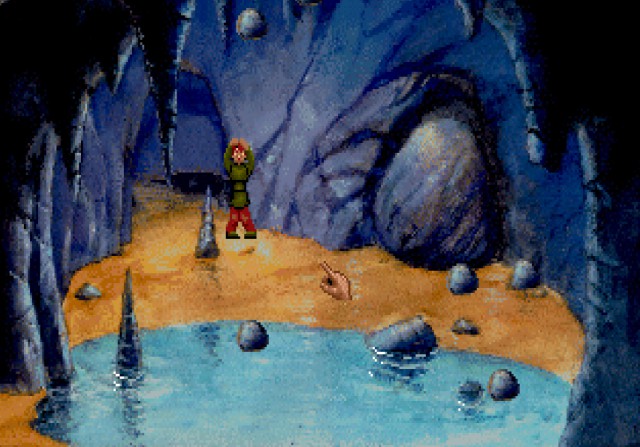
The Curse of Enchantia
In 1993, LucasArts released two of its great gems: Day of The Tentacle and Sam & Max. Day of the Tentacle (DOTT) was the second part of the illustrious Maniac Mansion, only in this installment it looked better than ever. It was the eighth game to use LucasArts’ SCUMM engine, and it was undoubtedly another of the most iconic titles in point-n-click history. A title full of irony, crazy humor, iconic characters, as well as including one of the best villains of the genre: the purple tentacle. If it was not enough to compete with a mummy in a beauty pageant, to travel to the past, present and future, there are really few more crazy things we can think of to translate into a video game.
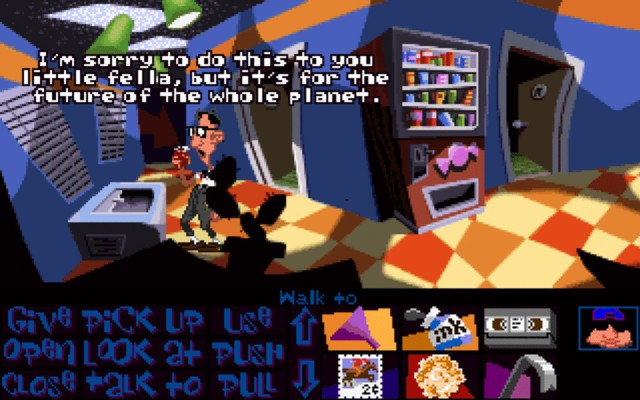
The last hope to save the planet earth: “use hamster” in “freezer”
The arrival of Sam & Max (1993) was a renewed air for the company, which until now had proposed games based exclusively on the concept of adventure. With this new title, we find ourselves in a plot that rather started from a police concept, represented by two anthropomorphic characters: a dog and a rabbit. In addition to many subliminal winks in many of its games, Sam & Max shines for the charisma of its antagonistic characters, through their coarse and mischievous jargon, being a thriller full of puzzles and irony. It was the ninth game to use the SCUMM engine interface, although unlike the previous ones, it was the first to discard the classic interface of “
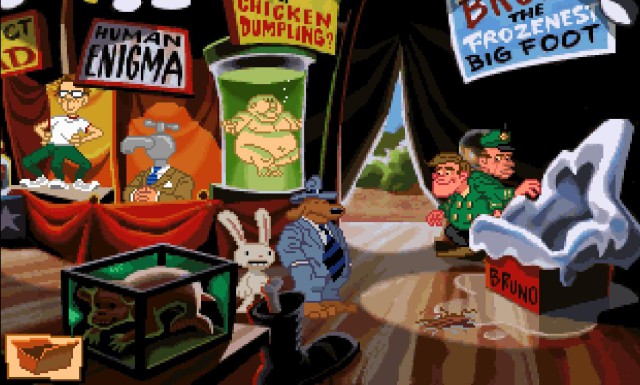
Sam and Max (1993)
Taking off the classic adventures of Sierra or LucasArts, that same year the Adventure Soft company published the title Simon The Sorcerer (1993). In this one, we put ourselves in the shoes of Simon, a young apprentice magician. With a start similar to The Curse of Enchantia, and setting similar to the classic Gobliiins (1991), Simon is teleported to another dimension discovering a world of magic and fantasy. The setting of the game draws on many classic tales and references of the genre from the books of the prestigious author Terry Pratchett to the master J.R.R Tolkien. His sense of humor and parody was more than present throughout the game.
At the moment, Monkey Island’s humor was subtle and clever. I found it funny, so that was the sense of humor we had to get. Simon Woodroffe, Simon’s screenwriter.
Myst was the first point-n-click in history that focused on providing a first-person view. Designed by brothers Robyn and Rand Miller, until 2002, it was the best-selling PC game in the world. His visual prominence represented a major leap forward in the industry through his ultra-realistic renderings that relied heavily on emerging CD-ROM technology. Myst’s interface is reduced to a single cursor for navigation and interaction; Instead of searching for items, the game focuses on finding subtly placed clues and manipulating complex machinery. A very popular concept in the genre and that we can see embodied in some Syberia puzzles or in the current The Room.
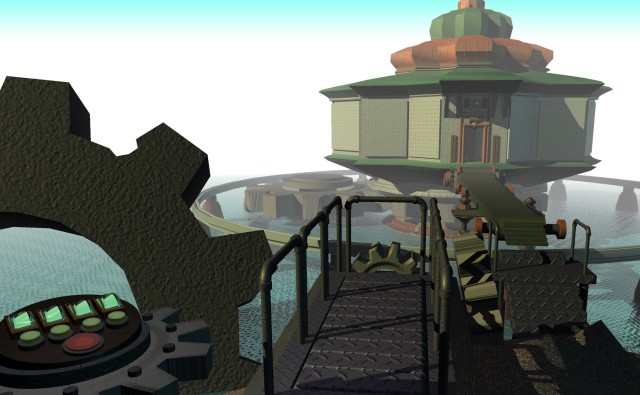
Myst (1993) one of the most influential and sold games of the genre
Thanks to the technological advancement brought about by the CD-ROM, Myst was the first game to be called “first person point-n-click”, going from the usual concept of third person to first person and becoming protagonists
Please Insert Compact Disc
Do you remember the arrival of the CD-ROM? With this we change previous primitive formats such as floppy disk to go to the highest and most sophisticated technology of the CD-ROM. Although good, it also had (and has) its things, like its usual: “The optical disk drive cannot read / recognize a disc” in which we had to remove the CD from the player and clean it carefully over and over again so that was read and executed by the machine. There is no doubt that all technology has always had its peculiarities, from rewinding cassettes with a pen to blowing into Game Boy cartridges. Technology has always been synonymous with quality and that is why many developers at that time wanted to take advantage of the compact disc by betting on its high technical performance. A few years later, with the CD-ROM on the market, LucasArts published Dig (1995), a title inspired by Steven Spielberg that dealt with a concept that fascinated many at that time: the existence of intelligent life on other planets, or in other words, aliens of all life. At that time, television series such as The X-Files and films such as ET or the Alien saga were established that repeatedly raised this idea in the industry. Dig was born under this concept, a title that was differentiated by its absence of the usual humorous tone (like Loom) of LucasArts, which tried to solemnize its plot inspired by a powerful story based on science fiction.
That same year, the title Full Throttle also saw the light, an adventure set in a distant future with a motorcycle aesthetic, with a very enveloping plot that catapulted it as a cult reference within point-n-click. His motto on the cover of the game was already a declaration of intent: A Heavy Metal Adventure.

Full Throttle (1995): A Heavy Metal Adventure
Broken Sword (1996) and its sequel are fondly remembered alongside the Lucasarts classics of the time. After some less well-received 3D sequels, Revolution Software recently released a fifth game in the series, returning to the classic 2D game. In this one, our character George Stobbart travels to various places like Ireland and Spain to discover the history behind the Templars and the Broken Sword. Its first version in 1996 pleasantly surprised critics both for its graphic section and for its dubbing into Spanish, since precisely the latter was lacking in the genre at that time.
On this occasion the pink panther also left its fiery mark within the point-n-clicks. The best known panther on television, had a little hole particularly in Spain, with its arrival in graphic adventures in 1996. Since in fact, at the end of the 90s, the title was sold in CD-ROM format as a supplement for newspapers such as “La Vanguardia”, making the graphic adventure of the pink feline even more popular. The American company Wanderlust Interactive published one of its first titles with “Pink Panther: Dangerous Mission” that directly competed with the graphic adventure of Ace Ventura launched that same year. Two years after its monumental success, the panther starred in a second installment with “Pantera Rosa Abracadabra Rosa”. Both titles that were rather intended for a children’s audience, penetrated the heart of many homes, being a fun educational proposal as well as endearing (their musical numbers were pure fantasy).
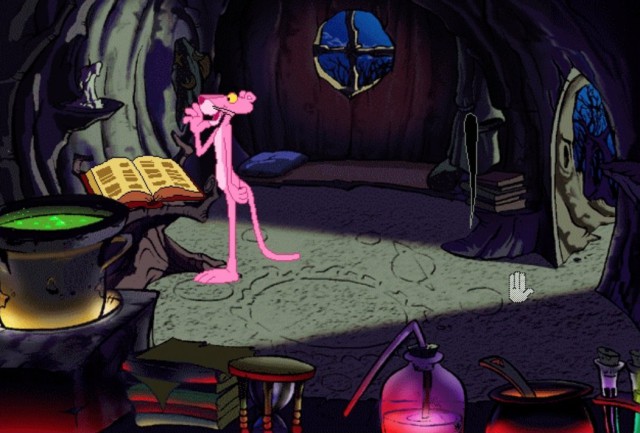
Pink Panther: Pink Abracadabra
Point-n-click fever made in Spain
It is well known that Spain was one of the cradles of success for many developers in the country. We saw it in the beginning with studios such as Indescomp, Dinamic, Zigurat, Topo Soft and Ópera Soft, which specifically gave us one of the greatest 8-bit gems with the Abbey of Crime. Subsequently, new studies emerged that came stomping and took over the point-n-click genre. Is Pendulo Studios you?
In 1993, many developers did not go through their prime. Many closed, and others struggled to maintain their coveted place in a competitive sector that was increasingly in demand and demanding. That same year, Pendulo Studios landed on the market to dominate the genre and compete with the heavyweights of Sierra and LucasArts. His debut feature “Igor” in 1994 did not have its best repercussion, until he embarked on his second project: Hollywood Monsters in 1997. A title that had all the ingredients to guarantee its success under a classic structure, an imposing cartoon aesthetic and an original wild plot. Its characters based on the classic Hollywood horror myths of the 50s, its puzzles and the twists of the script it posed, caused an overwhelming success. Hollywood Monsters being today the Spanish icon par excellence of point-n-clicks. Extra, Extra, tonight is Hollywood Monsters! The Quill, The Quill!
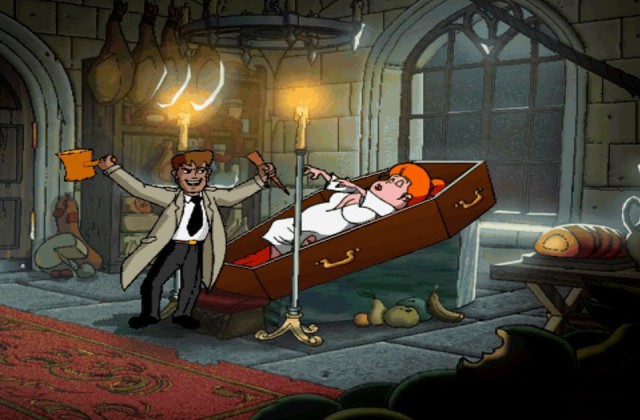
Hollywood monsters
Another reference title of the time that we cannot ignore is Drascula, a game that drank from a concept similar to Hollywood Monsters, based on the character of Dracula. The game was developed by Alcachofa Soft, a studio from Toledo that later also gave us other jewels such as “La Abadía” in 2008.
Third parts were never good. Or if?
“The Curse of Monkey Island” (or in other words Monkey Island 3) was the last LucasArts game to use the usual SCUMM engine. This engine evolved by creating its own “share currency” through the cursor, and drastically reduced its in-game actions to three: “
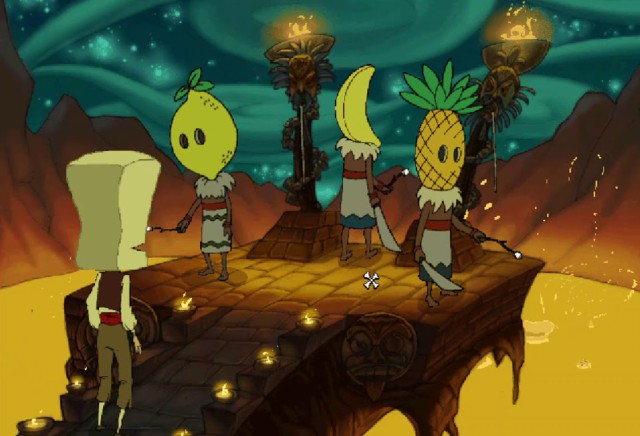
2020 if it were an image: “Use cheese” in “Lactose intolerant volcano”
15 years after the on-screen premiere of Blade Runner, Westwood Studios released their own point-n-click graphic adventure based on the film in 1997. Originally released on four CDs, Blade Runner remains a true classic within the game. modality. Titles like Beneath a Steel Sky had already used the format to tell Blade Runner-inspired cyberpunk stories, but the game’s underlying structure turned out to be its most innovative element. Its totally transgressive aesthetics, and mechanics where there was no single solution to solve its puzzles, inspired many later titles.
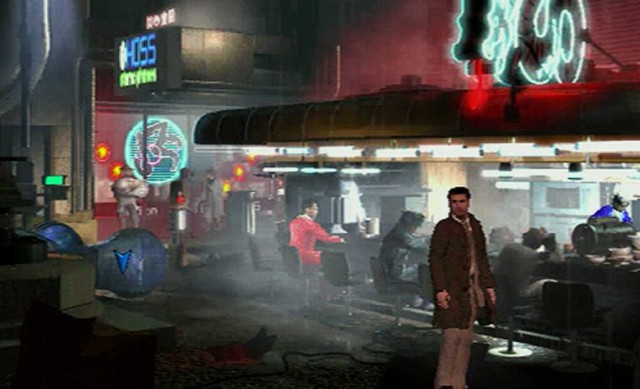
Blade runner
William Mulder and Dana Scully also entered the world of point-n-click. By 1998, the X Files series was in its 6th season and was more than established on the televisions of many homes. Up to 7 CDs in its PC version and 4 in its PS1 version, in this proposal we are immersed in a video-adventure. With more than 748 adventure pages with a multitude of options available to players and with three different endings, we can say that it was a somewhat original bet. En el juego debíamos encontrar a los dos conocidísimos agentes especiales del FBI que habían desaparecido misteriosamente mediante la investigación clásica de campo: búsqueda de pruebas, uso de gafas de visión nocturna, kit de pruebas, PDA y muchos elementos que permitían hacer sentir al jugador como un verdadero investigador propio de CSI Miami.
Mi nombre es Manny Calavera y soy tu nuevo agente de viajes
Considerado por muchos la mejor aventura gráfica de la historia, encontramos Grim Fandango (1998) orquestado por Tim Schafer (partícipe en muchas de las anteriores obras de LucasArts). En el juego encarnábamos a Manny, un humilde segador de almas de ambiciosas aspiraciones que se ve envuelto en una trama anti-corrupción que desemboca con el anhelo de llegar al Noveno Infierno. Bajo un estilo “film noir”, el título se basó en la mitología mexica y sus creencias relacionadas con la muerte y la tierra de los muertos.
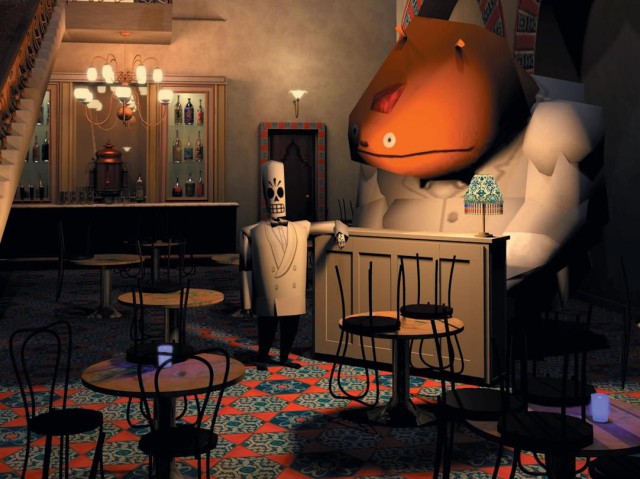
Glottis y Manny siempre en nuestros corazones
Su primera versión en 1998 no fue considerada un point-n-click como tal, ya que más bien tomaba un control de dirección rotativa (estilo tanque) sobre escenarios 2D prerrenderizados a través del teclado. Con la transición al 3D, LucasArts apostó por unos controles de teclado y gamepad, en lugar de usar los controles populares del mouse, hasta 2015. En enero de ese año, Double Fine lanzó una versión remasterizada del juego con gráficos mejorados, que incluyeron unos nuevos favorecidos controles point-n-click. Grim Fandango fue el primer juego de aventuras de LucasArts que abandonó el motor SCUMM por el 3D Grim Engine (de ahí su nombre) y fue usado posteriormente en títulos como Monkey Island 4: La Fuga de Monkey Island en 2000 para PC y PS2, The Longest Journey o Mist 3.
Hasta aquí concluye la primera parte de la historia de los point-n-click. ¿Los conocíais todos? Estad atentos para la segunda entrega.

